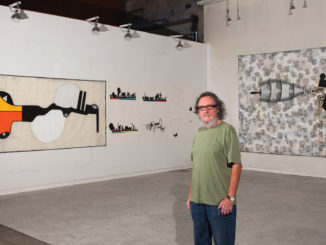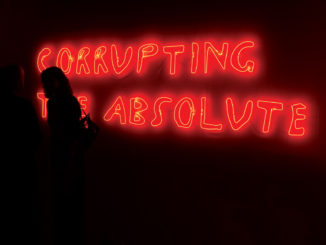 Little I really know about the city’s public transportation system, about how it all works, or where it goes, or from where to where. However, Miami has it all: The Metrorail, the Metromover, bus-lines traces. It all make sense, or maybe it doesn’t – thinking on how many people I know that actually make use of public transportation in Miami. Except for my landlord, that doesn’t have a car and has been forbidden to drive by his doctor, I cannot think on anybody else.
Little I really know about the city’s public transportation system, about how it all works, or where it goes, or from where to where. However, Miami has it all: The Metrorail, the Metromover, bus-lines traces. It all make sense, or maybe it doesn’t – thinking on how many people I know that actually make use of public transportation in Miami. Except for my landlord, that doesn’t have a car and has been forbidden to drive by his doctor, I cannot think on anybody else.
I came across the Miami Metrorail, after being commissioned to write about the art that is located at its several stations. How obvious can I get? Anyways, I recurred to modern magic and Googled for information on the Metrorail, on how it works, where it goes, and from where to where. Here is what I found: “The Miami Metrorail operates on 22.4 miles of elevated track with 22 stations from Dadeland South to Palmetto. The service hours are 24 hours, with train headways every 6 minutes during rush hour, every 15 minutes during midday hours, and every 30 minutes after 8:00 p.m. on weekdays. Weekend service runs every 20 minutes. Free transfer is offered to the MetroMover by using a special exit at the Government Center and Brickell stations. Change / token machines are available at all stations since no station agents exist.”
Awesome. So there it is, all I need is to get on. Of course I could have visited every station by car, but that wouldn’t be as much of a “new experience” as riding the Metrorail promised to be. Soon after gathering all the information I needed, I was ready for my move. Got a map with several marks and notes about the artworks – the usual who and what is where -, picked up my blackberry and sun glasses – I don’t carry and Ipod so I guess I was “Ipod cliché” free – and there I was, enjoying a Saturday morning “drive” towards the most southern Metrorail station: Dadeland Station. No plans but to head northbound on the train and eventually get off and on to check out the artworks at the stations. Am I exited? I don’t know… There is no need to get silly. I just need to see the art and write the story due. It’s no difficult task I thought, after arriving at the first station.
Two gigantic metal pseudo vehicles located outside the station building welcomed me. The work consists of two “modern” neo-bicycles representing a sort of commuting from the suburbs to the urban areas. Created in 1984 by George Greenamyer as part of the Miami Dade Department of Cultural Affairs Art in Public Places program, 16 Smokes was inspired by the rapid growth that Miami was experiencing at the time. It uses references of the pre-industrial era, when smoking machinery and complicated combinations of dented wheels symbolized progress and development. Natural from Cleveland, Ohio, Greennamyer considers himself a “public sculptor” who finds inspiration in structural engineering. Many of his sculptures and kinetic works can be seen at many other cities’ public spaces like New York, St. Louis or New Orleans.
So far so good. I’m at the station waiting for a train. In Miami. Ok. Few people around doing the same I guess. I try to see if I’m the only one that is new to the experience and it seems to be so. There is a young couple having an animated conversation, a proud old lady wearing makeup and everything, plus two homeless guys that don’t look quite alright, but I’m worry-free. It’s a beautiful morning. The train arrived on time, we all got in, while a young man came in across the sliding door at the last minute, just to rapidly take a seat near a window and stuck his ears with tiny white earphones… and off we go. I’m definitely the only one new to this.
I know from my list that there are works at University Station, such the light installation named Making Purple, by disappeared Cuban-American artist Fernando Garcia but it was already covered by MAG some time ago, so I decided to pass it and make my first stop at Douglas Road Station to see Leaning Arches created by Athena Tacha also in 1984.
The work was built out of four sheets of Cor-Ten Steel, which were cut and then pulled apart with great force to form a series of arches connected alternately at the top and bottom. To further enhance the forces of rhythm and tension by which the arches were formed, the piece was painted a deep purple on one side, and a persimmon orange on the other. The work was recently restored to its original colors after a long period of weather and pollution erosion and it now shows its luminescent glow. The persimmon orange and deep purple, bounce off of each arch producing wonderful reflections under the morning light. Athena Tacha was born in Greece in 1939 and came to the US in 1960 to continue her art studies. Ever since, she has developed an impressive portfolio of public works and sculptures that can be seen across the nation.
Back on the next train, I noticed that wagons are quite clean and modern, and I wonder how it would be like during weekdays. I bet many people benefit from it. Right now it’s almost empty, carrying only few passengers, but I didn’t mind about them since I’ll get off on the next station: Coconut Grove Station. Sun Stations is the work created by Dale Eldred for Art in Public Places program in 1983. It’s best seen from the Dixie Highway (US1) side of the station. The work consists of a three-part solar sculpture that converts sunlight into unexpected bursts and flickers of pure color. The artist became known for his installations designed to split sunlight into its color elements, producing luminous fields of energy and intense radiant light. Tragically disappeared in 1993, Eldred left a legacy behind that can be appreciated from Tulsa, Oklahoma, to Helsinki, Finland; and thanks to Art In Public Places, also here in Miami.
Minutes later I’m back on the train. I decided to over-pass Vizcaya and Overtown Stations and go all the way to Santa Clara Station for Ceremony of the Tropics, created by Carlos Alfonzo in 1986. The train literally feels like flying and I see Miami passing by really fast: roofs, townhouses, expressways, cars… It’s so spread-out. Meanwhile, I think about how these works have been preserved for all these years. Associated to the Metrorail alone, Miami-Dade Art in Public Places program has allocated fifteen works all along its twenty-two stations. According to their website, it “has acquired or commissioned over 700 works of art and gained international recognition as a leader in its field”. I think that’s a major contribution to the city’s artistic patrimony. Between my inner speech and time and train flying I’m already at Santa Clara Station.
Ceremony of the Tropics, created by Carlos Alfonzo is a vibrant handcrafted ceramic mural, an explosion of color and allegoric symbols from that region. Laid out with the post modernist style that characterized his work, the mural, as in the artist’s own words, “celebrates the relationship of nature and man”. It fuses elements from Classical Modernism, Surrealism, Cubism and even Abstract Expressionism, and mixes everything as in a fruit cocktail; seductive and delicious. Carlos Alfonzo arrived in Miami in 1980 from his natal Cuba and soon after achieved recognition as an artist, just before dying of AIDS in 1991.
I look at my notes. There is a steel sculpture by Gene Kangas at Allapatha Station dated 1983, a blue-stone Installation at Earlington Heights Stations by Beverly Buchanan from 1986, a wall installation by Betye Saar at Dr. Martin Luther King Jr. Station, and a Purvis Young mural at Northside Station, both from 1986. Young’s work in particular tributes the contributions of construction workers in building Miami’s transit system. But my choice for the next stop is East / West, created by Miami-based artist Robert Huff in 2003 at Palmetto Station. I took the following train and 20 minutes later I arrived at the northbound’s last station.
East / West, was conceived by the artist to match with the hours of daily commuting, so I guess that there is commuting after all. Upon entering the platform we can see that colorful tiles have been attached to the support structure of the station. Their variations in color resemble the warm shades of the rising sun for passengers taking the train southbound, but if you are arriving on a train like me, you are greeted with a progression of shades grading from the hot sunset orange, to the bluish coldness of the early evening. Robert Huff was born in Michigan in 1945 and received a M.F.A. from University of South Florida in 1968. Other public works by Robert Huff in South Florida can be seen at Fort Lauderdale International Airport and Port Everglades Administration Building.
My art move on the Metrorail reached the end. How do I feel? Ok… It was a peaceful ride. Every train on time and art at every station that I actually got off equals the job done. What now? Lunch? or going back to my car at Dadeland South Station? Lunch? Car? Lunch? Car!By Abel S.



Be the first to comment